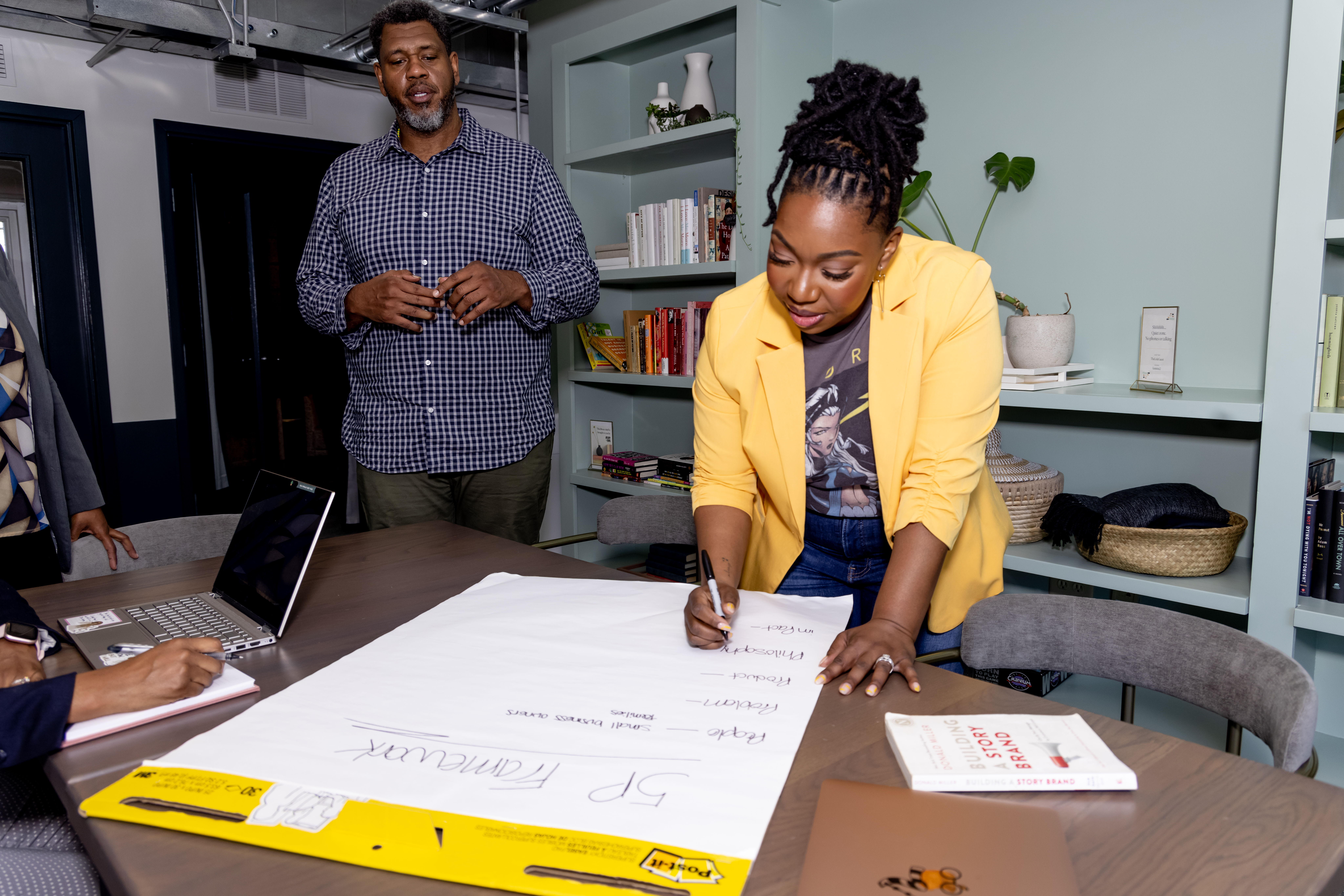
"The 3Ps," he said.
My brain exploded. The simplicity of it cut through my tendency of overthinking that had me working on beefing up our brand strategy sessions vs paring them down.
"It's so simple, no need to complicate," Enoch (our digital marketing lead and growth strategist) explained.
The 3Ps...
- People: Who are you serving?
- Problem: What problem(s) are you solving?
- Product: What offering(s) are you providing?
While I was an avid user of Simon Sinek's Golden Circle that has notoriously given brands guidance on how to realize their core why, how and what, it's more company-centric vs incorporating a more customer-focused approach like we were wanting to have for our clients' needs. Because of this, I usually had to pull the "who is your customer" bit out of our people in a way that was not necessarily inclusive of the Golden Circle method.
Enter Enoch's 3P approach.
Since then, we've cemented our method by remixing the Golden Circle for what made the most sense for what our people needed and what they were trying to achieve.
Thus, the 5P Framework was born. Now let's break down what it means and how you can use it for your own small business or early-stage nonprofit.

Brand Framework Workbook (16 templates)
$249.00Ditch the stress. Lose the frustration. Snap into the "I know exactly how to grow my brand and business" era.
Take what we do for our clients and DIY it to design the life you've dreamed your business could create for you.
The 5P Framework
To gain a deeper understanding into the core of our client's businesses and brands, we believe you should know your target audience and community impact FIRST.
From our perspective, these are the most crucial elements that inform your WHY. (Especially if you’re a BIPOC-owned business since an estimated 6.4 million women of color-owned businesses employ nearly 2.4 million people and generate $422.5 billion in revenue. Meaning BIPOC women-owned businesses can be crucially impactful on our communities.)
That’s why we created the 5P Framework, a remix to Simon Sinek’s Golden Circle. We use it during our in-person brand strategy session with our clients and it's how we extract the essence of what makes you and your brand unique so let's get into it.
First up, your people.
Defining your customer is (we can't stress this enough) mission critical.
You never want to talk to everyone because then you're talking to no one.
Be specific.
Ask yourself — or if you can, ask your customers through a feedback survey:
- Where do they live?
- How old are they?
- What do they hate?
- What brings them joy?
- What do they believe in?
- What do they love to do?
- Where do they frequent online?
There are so many free tools and resources out there that can make knowing who your people are easier done than said. Use tools like Hubspot's free Persona Builder to have a concrete ideal customer profile that will root your business in everything it does.
The problem that your people are facing.
Related to your business of course, what problem does your target audience have? What's causing the problem (this is good for understanding and accounting for context)? How does the problem they're facing make them feel?
When you can speak on all the specific problems your people are facing, it makes it a million times easier to create direct answers (or offerings) that don't have any guesswork in them — greatly increasing the likelihood of your success.
You're only as good as your offer, or promise.
For our team, we know that our people want their marketing to work for them and grow their business and brand, so naturally our answer goes directly to the root of that problem: brand development designed to support 5-10x growth.
We also know that they don't want to — nor should they — do all of this brand and marketing stuff themselves. They're not the experts and they don't want to be. They want to focus on creating innovative craft cocktail experiences, trustworthy salon services that never leave your hair damaged or your time wasted, coaching that manifests goals and dreams into living reality, and the list goes on.
The same thing goes for what you're offering your people.
What are the products/services you plan to offer (or are currently offering) that directly (or indirectly) solve the problem that your people face?
Write out all of what you can do and then tie each offering directly back to your people's problem and its various facets, aspects, and context. Then rinse and repeat every time you're thinking of cooking up something new.
Standing on intrinsic, for your philosophy and impact.
Remember, we're all human. That means a few things.
According to Douglas van Praet, that means we are all beholden to our intrinsic needs, that all weirdly start with the letter "S." (Anyone else having a Sesame Street flashback?)
- Security
- Safety
- Sustenance
- Status
- Sex
- Survival
Your philosophy and impact should dial into these needs that all of us humans have.
For example, this is our client's philosophy:
I believe I can transform my clients’ lives through the rejuvenation of their hair. By instilling the love that my people's hair truly deserves, I can make a change in how they see themselves and uplift their confidence by creating a nurturing environment of trust and authenticity — a true hair ministry.
Her philosophy is clear on what her brand values are and what her business won't tolerate, all in one breath. It leans into the intrinsic needs that her clients have to feel safe with who they trust to touch their hair, secure in how they look, and even an elevation in status for who they can become because of that transformation when they get out the salon chair.
We created her philosophy by blending and polishing her answers to these main questions:
- What values does your business move by?
- What won't your brand tolerate?
- What guides and defines its decisions so it's always in alignment with what it offers, how it operates and who it partners with?
Ask yourself those same questions and jot down what values align with your brand and business.
Then sit with it.
Polish it.
Then for your impact, ask yourself these:
- What is your business and brand working to accomplish?
- How are you affecting the lives of your people?
- How do your actions affect your community/your peoples' communities at large?
Keep finessing these until you've got solid statements for your values and impact that feel right and in line with what you're doing — and how you're doing it.
Everything your brand and business stands for, produces, makes people feel, and more, starts here.
Use this 5P Framework to your advantage. When you've gotten these sentiments down, you'll be able to apply for grants and funding, quickly and easily talk up your business in seconds, move people in person and online, and ultimately spark visible growth for your brand and business.
